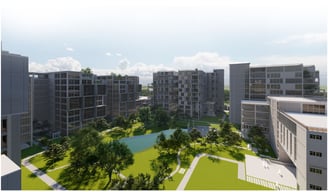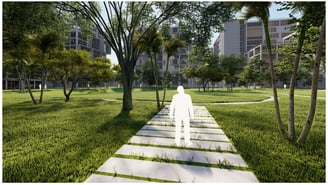April 2022
Project: Post-COVID Health Space Regeneration


This research project examines post-COVID health space design issues such as how to create resilient spaces with a focus on airborne nanoparticles and microfluidic components, how to modify air ventilation systems, and most importantly, what modifications to spatial configuration and FEM simulation approaches to determine the impact and solutions should be made.
Related Publications
Abstract Accepted:
· A multiple variable regression model analysis using space syntax for post-covid 19 health space regeneration and standard prognosis
Conference: 7th International Conference on Civil Engineering for Sustainable Development (ICCESD-2024)
Manuscript Under Review:
· Analysis of PM 2.5 Exposure Impact in Different Atmospheric Contexts: A Detailed FEM Simulation Analysis in A Virtual LOAC Device
Conference: 6th International Conference on Electrical Information and Communication Technology (EICT - 2023)
· Analyzing Numerical Simulation of Ventilation System And Filter Membrane: The Exposure of Airborne Nano-Particles In Health Interior Space
Conference: 6th International Conference on Electrical Information and Communication Technology (EICT - 2023)
Work In Progress:
· Environmental Health equity- Spatial and functional recommendation for post-covid Housing
( Data Collected in 2021, to be submitted for publication in Fall 2024)


~ UNIDIRECTIONAL HUMAN FLOW COULD REDUCE 60% of VIRAL BEHAVIOR.


Want a research collaboration?
Related ARTICLES
RESEARCH COLLABORATORS


Muhammad Golam Sami
B. Arch, Khulna University of Engineering & Technology, Khulna, Bangladesh Architect | Futurist | Sustainable Design Expert
Operational Head, ADORA Studios, Bangladesh
Founder, samism.org
Lecturer, Department of Architecture
Northern University of Business & Technology


Mahmuda Yasmin Dola
B. Arch, Khulna University of Engineering & Technology, Khulna, Bangladesh Architect | Analytical Practitioner
Head of Construction, ADORA Studios, Bangladesh
CMO & Head of Construction, SS Construction & Power Solution, Bangladesh
Project: Post-COVID Health Space Regeneration
This research project examines post-COVID health space design issues such as how to create resilient spaces with a focus on airborne nanoparticles and microfluidic components, how to modify air ventilation systems, and most importantly, what modifications to spatial configuration and FEM simulation approaches to determine the impact and solutions should be made.
Muhammad Golam Sami, Mahmuda Yasmin Dola
4/13/20222 min read


